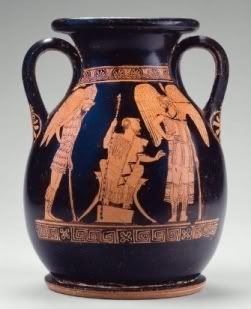Whose Art?
 While I believe that the looting of art and the illegal trafficking of antiquities are to be condemned, I think hypocrisy is also to be condemned. This week, the Boston Museum of Fine Arts transferred to the Italian Ministry of Culture thirteen objects from its collection that the Italian government determined to have been looted and sold illegally to the MFA. A similar transfer occurred in February of this year when New York’s Metropolitan Museum of Art returned twenty objects, including the 2500-year old Euphronios krater, to Italy.
While I believe that the looting of art and the illegal trafficking of antiquities are to be condemned, I think hypocrisy is also to be condemned. This week, the Boston Museum of Fine Arts transferred to the Italian Ministry of Culture thirteen objects from its collection that the Italian government determined to have been looted and sold illegally to the MFA. A similar transfer occurred in February of this year when New York’s Metropolitan Museum of Art returned twenty objects, including the 2500-year old Euphronios krater, to Italy.Naturally, the objects were not returned because it was determined in principle to be wrong for an American museum to possess antiquities from Europe. The issue was that the lawful provenance of the objects themselves could not be demonstrated. The Italian government argued that they had been looted and were subsequently sold to the MFA by dealers who had themselves acquired the objects using sketchy means.
However, a case can be made that many of the world’s antiquities residing in museums were, at some point in their history, removed illegally from their place of origin. Certainly this is true of the Parthenon Marbles (aka the Elgin Marbles) and many other antiquities from Greece that were unlawfully taken from Greece during the era of Ottoman rule and earlier.
For example, it should be noted that six of the thirteen objects returned to Italy this week were originally produced in Athens during the fifth century BCE. I doubt very much that the Italian government can prove that these six objects were lawfully removed from Greece in the first place. It cannot possibly be demonstrated that they were legitimately purchased from the Greek state (since the Greek state did not exist prior to the first quarter of the 19th century) or from the artist or the original Greek owner (since no bill of sale exists).
While it is possible that they were transferred to Italy by means of legitimate trade at some point during their long history, there is no documentation demonstrating this to be the case. What is perhaps more likely is that these six objects were looted from Greece before they were looted from Italy and later sold on the black market. In that case, shouldn’t they be returned to Greece, rather than Italy?
Shown above is one of the thirteen returned objects: a two-handled jar (pelike) depicting Phineus with the sons of Boreas (Ceramic, Red Figure, Greek, Classical Period, ca. 450 BCE, the Nausicaa Painter, Place of Manufacture: Athens, Attica, Greece).












2 Comments:
The Metropolitan Museum's collection is incredibly famous but it is known that a lot of its holdings come from sources whose integrity is dubious.
Especially during the directorship of Thomas Hoving, a time of enormous growth in the Museum's collections, many objects appeared suddenly and seemingly out of nowhere.
I don't mean to suggest that the Met is in any way unique. The seizure of antiquities was the way of the world for quite some time. From the parading of the Jewish ritual vessels through Rome during Titus's reign, to the Venetians taking the four bronze horses from the Hippodrome in Constantinople for St. Mazrk's Basilica, to the mass of Egyptian objects in the Louvre and beyond, military occupations have always resulted in the rape of culture.
That was a very interesting read, I wonder myself what proofs Italy can offer up to determine just how they were acquired from Greece in the first place.
In an ideal world they should be housed in a Greek museum, returned to the soil from whence they came.
At least that is my opinion.
:)
Post a Comment
<< Home